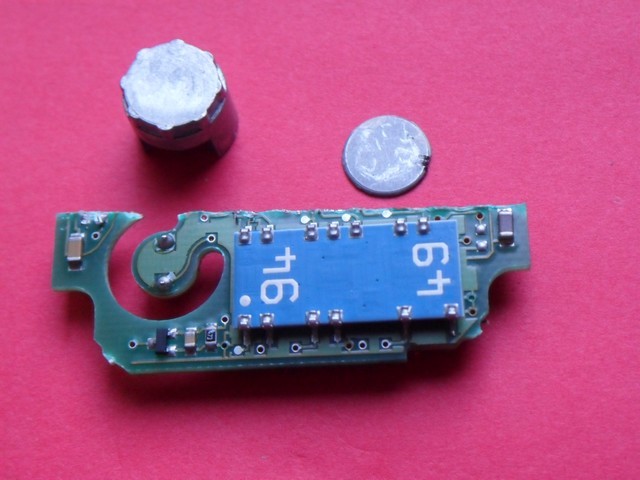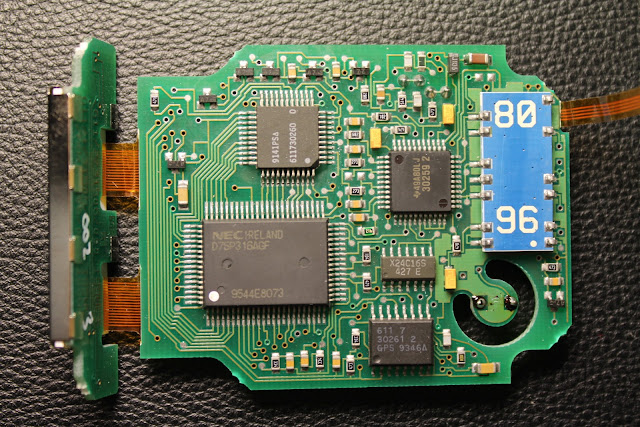 |
| front (please excuse the violet background, I'm not the author of the picture...) |
 |
| back (© goodgadgets2u) |
If you are still clueless about WTF is that, you are looking at the business end of a Siemens EPD-1D gamma dosimeter. Three PIN photodiodes (no idea on actual part number), each with a different level of shielding. The opaque one has a thick lead alloy shield around it (pictured above it), the right one seems to have a thin lead disc on top and the middle one is covered by thin aluminium foil supported by a polymer substrate.
The blue thing are three separate very sensitive FET amplifiers.
Instead of the sawed off guts, I got an entire unit (non-functional though).
 |
| front © me (you can shamelessly steal these) |
The unit did do something after being connected to power and restarted, but after performing a self-test and a few beeps, it always stopped reacting, while displaying an error.
So, autopsy time:
 |
| front cover, backside view (note the shields for the diodes) |
 |
| back cover, backside view |
 |
| back cover, front side view |
 |
| PCB, front note the second piezzo buzzer (no idea why) |
 |
| PCB, back |
 |
| PCB, back (again) (slight corrections so that everything is readable) |
I have no datasheets on the other ICs though.
I'm just speculating, but the IC closest to the blue amp board is probably an ADC, the logo is Texas Instruments, but the search on their website returns nothing.
(Feel free to contact me if you know anything about any of these ICs)
Other than that, there are two crystals, one is for the CPU (1 MHz), the other is a real time clock (32.768 kHz). Note that the 1 MHz crystal has a ceramic package with a transparent window, so you can actually see the crystal itself (the thin rod in the middle).
That about wraps up the summary of interesting stuff I can tell about this board. (for now, at least)
I'm still in the process of reverse engineering the PCB, since actually I need to finish building a capacitance meter first (SMD capacitors do not have the value displayed on them and the coloring is not standardised). I'm really only interested in the analog part of the detector, so I can rebuild it with a different MCU.
All will be posted in due time, so until then...
Got one of these on ebay. Strage stuff and siemens does not provide any manual/info/resource (I hate them).
ReplyDeleteMine has no connection for the batteries, can you show a close up of the battery cable? Thanks
http://aka-the-a.blogspot.cz/2015/04/moar-pictures-of-siemens-epd-1-guts.html
ReplyDeleteHave fun...
btw this is a professional dosimeter, as a manufacturer you absolutely do not want people hacking it, so don't blame Siemens for being so secretive about it.
It's also VERY old - again, can't really blame the manufacturer that they do not keep a freely accessible copy of every manual to everything they make...
hello guys, after some googling i have found resources (tech notes and something what seems to be the control software!) see: http://www.qsl.net/k0ff/01%20Manuals/Siemens/ I plan to establish comm link with EPD and computer in the near future, which seems to be possible after some poking around .. for now happy hacking :)
ReplyDeleteHi, do you have saved the SW from the link, it's unavailable currently
DeleteI have readed EEPROM.
ReplyDeleteI play few time with content. Some "records" can be erased / changed.
My device measure max dose 9999.9 and are little loud in this time. (Alarms).
So probably something is broken. Now I have not too much time for investigate.
PS. Iceman. You must have reader for it. Reader is not only interface - this have some MCU andtranslate command from PC to EPD
zdravím.Mám jinej menší,EPD MK 1. po zapnutí nic nedělá.. satelitakxy@centrum.cz
ReplyDeleteZdravím. Mám menší.. SIMENS EPD-MK2.2. po vložení baterie nic nedělá...
ReplyDelete